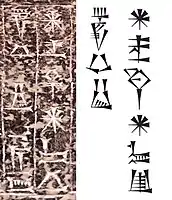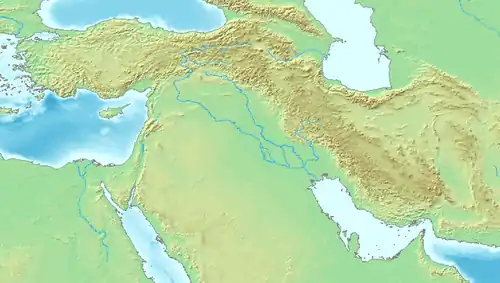Isin-Larsa period
The Isin-Larsa period (circa 2025-1763 BCE, Middle Chronology, or 1961-1699 BCE, Short Chronology)[1] is a phase in the history of ancient Mesopotamia, which extends between the end of the Third Dynasty of Ur and the conquest of Mesopotamia by King Hammurabi of Babylon leading to the creation of the First Babylonian dynasty.[2] According to the approximate conventional dating, this period begins in 2025 BCE and ended in 1763 BCE.[1] It constitutes the first part of the Old Babylonian period (2025-1595 BCE), the second part being the period of domination of the first dynasty of Babylon, which ends with the Sack of Babylon in 1595 BCE and the rise of the Kassites.[2]
Isin-Larsa period | |||||||||||
|---|---|---|---|---|---|---|---|---|---|---|---|
| c. 2025 BCE – c. 1763 BCE | |||||||||||
| Capital | Isin and Larsa | ||||||||||
| Common languages | Akkadian language | ||||||||||
| Religion | Akkadian religion | ||||||||||
| Government | Monarchy | ||||||||||
| King | |||||||||||
| Historical era | Bronze Age | ||||||||||
• Established | c. 2025 BCE (MC) | ||||||||||
• Disestablished | c. 1763 BCE (MC) | ||||||||||
| |||||||||||
| Today part of | |||||||||||
The Third Dynasty of Ur immediately preceded the Isin-Larsa period, and its fall was due to the combined attacks of the Amorites from the west, and the Elamites from the east.[3] As its name suggests, the Isin-Larsa period saw successively the emergence of two great powers in Lower Mesopotamia: the kingdom of Isin, which attempts to seek the succession of the kingdom of Ur after its fall and established the Dynasty of Isin, and the kingdom of Larsa, whose fall marks the end of the period.[2] In reality, neither of these two kingdoms exercised an undeniable hegemony in Lower Mesopotamia, and they had to coexist with other less powerful kingdoms (Uruk, Babylon, Mankisum...), while further north their influence was non-existent and gave way to other powerful political entities (Eshnunna, Ekallatum, Mari, Yamkhad). The dynasties of this period have in common to be of Semitic Amorite origin, even if they quickly acculturated to the Mesopotamian traditions.[2]
Isin as the main polity (2025–1924 BCE)

When the deteriorating Third Dynasty of Ur (Ur III) finally collapsed at the hands of the Elamites at the end of the third millennium BC, a power vacuum was left that other city-states scrambled to fill. The last king of the Ur Dynasty, Ibbi-Sin, had not the resources nor the organized government needed to expel the Elamite invaders. One of his governmental officials, Ishbi-Erra, relocated from Ur to Isin, another city in the south of Mesopotamia, and established himself as a ruler there. One of Ishbi-Erra's year names reports his defeating Ibbi-Sin in battle.[4]
Although he is not considered part of the Third Dynasty of Ur, Ishbi-Erra did make some attempts at continuing the trappings of that dynasty, most likely to justify his rule.[4] Ishbi-Erra had ill luck expanding his kingdom, however, for other city-states in Mesopotamia rose to power as well. Eshnunna and Ashur were developing into powerful centers. However, he did succeed in repulsing the Elamites from the Ur region. This gave the Isin dynasty control over the culturally significant cities of Ur, Uruk, and the spiritual center of Nippur.
For over 100 years, Isin flourished. Remains of large buildings projects, such as temples, have been excavated. Many royal edicts and law-codes from that period have been discovered. The centralized political structure of Ur-III was largely continued, with Isin's rulers appointing governors and other local officials to carry out their will in the provinces. Lucrative trade routes to the Persian Gulf remained a crucial source of income for Isin.
Rise and dominance of Larsa (c. 1924–1763 BCE)

The city of Larsa had been subject to the city of Lagash, which was captured by the Isin ruler Ishbi-Erra. Subsequent Isin rulers appointed governors to rule over Larsa; one such governor was an Amorite named Gungunum. He eventually broke with Isin and established an independent dynasty in Larsa. To legitimize his rule and deliver a blow to Isin, Gungunum captured the city of Ur. As the region of Larsa was the main center of trade via the Persian Gulf, Isin lost an enormously profitable trade route, as well as a city with much cultic significance. Gungunum's two successors, Abisare (c. 1841–1830 BC) and Sumuel (c. 1830–1801 BC), both took steps to cut Isin completely off from access to canals. Isin quickly lost political and economic force. Isin would never recover. Around 1860 BC, an outsider named Enlil-bani seized the throne of Isin, ending the hereditary dynasty established by Ishbi-Erra over 150 years earlier.[5]
Larsa grew powerful, but never accumulated a large territory. At its peak under king Rim-Sin I (c. 1758–1699 BC), Larsa controlled only about 10-15 other city-states — nowhere near the territory controlled by other dynasties in Mesopotamian history. Nevertheless, huge building projects and agricultural undertakings can be detected archaeologically.
The exact events surrounding Isin's disintegration as a kingdom are mostly unknown, but some evidence can be pieced together. Documents indicate that access to water sources presented a huge problem for Isin. Isin also endured an internal coup of a sort when Gungunum the royally appointed governor of Larsa and Lagash province, seized the city of Ur. Ur had been the main center of the Gulf trade; thus this move economically crippled Isin. Additionally, Gungunum's two successors Abisare and Sumuel (c. 1905 BC and 1894 BC) both sought to cut Isin off from its canals by rerouting them into Larsa. At some point, Nippur was also lost.
Demise
Hammurabi of Babylon founded the First Babylonian dynasty and united the whole region, after defeating the city of Larsa in 1763 BCE, as well as Eshnunna and Mari.[3] After the defeat of Rim-Sin I by Hammurabi of Babylon, Larsa became a minor site, though it has been suggested that it was the home of the First Sealand Dynasty of Babylon.[6]
Art
Artistically, the Isin-Larsa period is a period of turmoil, marked by the rise of the influence of the Amorites for the northwest of Mesopotamia. Life was often unstable, and non-Sumerian invasions a recurring theme. It is often difficult to distinguish between the art of Isin-Larsa and the art of the First Babylonian Dynasty, except when inscriptions permit datable attribution.[7]
.jpg.webp) Four-faced god, Ishchali, Isin-Larsa to Old Babylonia periods, 2000–1600 BC, bronze - Oriental Institute Museum, University of Chicago
Four-faced god, Ishchali, Isin-Larsa to Old Babylonia periods, 2000–1600 BC, bronze - Oriental Institute Museum, University of Chicago
 A praise poem to Iddin-Dagān, currently at Musée du Louvre
A praise poem to Iddin-Dagān, currently at Musée du Louvre List of the kings of Larsa, Louvre Museum.
List of the kings of Larsa, Louvre Museum.
 Ceramics from the Isin-Larsa period. Museum of Oriental Institute of Chicago
Ceramics from the Isin-Larsa period. Museum of Oriental Institute of Chicago Terracotta male figurine holding an axe or adze, from Tell Telloh, Isin-Larsa period, c. 1900 BCE. Iraq Museum
Terracotta male figurine holding an axe or adze, from Tell Telloh, Isin-Larsa period, c. 1900 BCE. Iraq Museum
References
| Wikimedia Commons has media related to Isin-Larsa Period. |
- Frankfort, Henri; Roaf, Michael; Matthews, Donald (1996). The Art and Architecture of the Ancient Orient. Yale University Press. p. 107. ISBN 978-0-300-06470-4.
- Arnold, Bill T. (2004). Who Were the Babylonians?. Society of Biblical Literature. pp. 38–39. ISBN 978-1-58983-106-3.
- Frankfort, Henri; Roaf, Michael; Matthews, Donald (1996). The Art and Architecture of the Ancient Orient. Yale University Press. pp. 93–95. ISBN 978-0-300-06470-4.
- Vaughn E. Crawford, An Ishbi-Irra Date Formula, Journal of Cuneiform Studies, vol. 2, no. 1, pp. 13-19, 1948
- William W. Hallo, The Last Years of the Kings of ISIN, Journal of Near Eastern Studies, vol. 18, no. 1, pp. 54-72, 1959
- W. G. Lambert, "The Home of the First Sealand Dynasty", Journal of Cuneiform Studies, 26 (1974), pp. 208-210
- Frankfort, Henri; Roaf, Michael; Matthews, Donald (1996). The Art and Architecture of the Ancient Orient. Yale University Press. p. 107. ISBN 978-0-300-06470-4.

